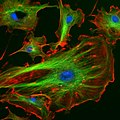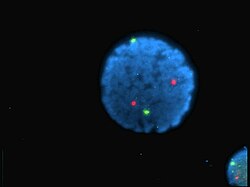Fluorescence microscope
A fluorescence microscope is an optical microscope that uses fluorescence and phosphorescence to study organic or inorganic substances.[1][2] "Fluorescence microscope" means any microscope that uses fluorescence to make a picture. This applies whether it is a more simple set up or a more complicated design.[3]
Most fluorescence microscopes, especially those used in the life sciences, are of the epifluorescence design shown in the diagram. Light of the excitation wavelength illuminates the specimen through the objective lens. The fluorescence emitted by the specimen is focused onto the detector. The dichroic beamsplitter acts as a wavelength specific filter, transmitting fluoresced light through to the eyepiece or detector, but reflecting any remaining excitation light back towards the source.
Fluorescence Microscope Media
Fluorescence and confocal microscopes operating principle
Human lymphocyte nucleus stained with DAPI with chromosome 13 (green) and 21 (red) centromere probes hybridized (Fluorescent in situ hybridization (FISH))
References
- ↑ Spring K.R. & Davidson M.W. "Introduction to Fluorescence Microscopy". Nikon MicroscopyU. Retrieved 2008-09-28.
- ↑ "The Fluorescence Microscope". Microscopes help scientists explore hidden worlds. The Nobel Foundation. Retrieved 2008-09-28.
- ↑ Juan Carlos Stockert & Alfonso Blázquez-Castro (2017). Fluorescence microscopy in life sciences. Bentham Science Publishers. ISBN 978-1-68108-519-7. Archived from the original on 14 May 2019. Retrieved 17 December 2017.




